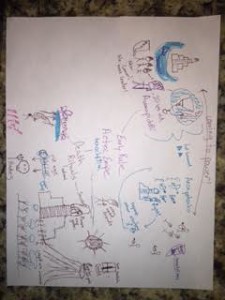This Concept Map maybe slightly hard to comprehend due to drawing abilities, but overall this did help me understand the details more greatly by looking at them at a different standpoint. In my concept map I wanted to look more in depth into the early creation of the Aztec Empire. The first true leader of the Aztec empire was actually a new comer to land. The Mexica people were in a time of distress and leaders looked to him. The map showed that during his time. His people fell in the rapid orbit of the different states battling the Azcapotzalco people. The bottom half I wanted to look a little more in depth into their ideas of death. There are three types of deaths that are valued by these people. There was human sacrifice in order to please the gods to keep the sun shining and the rain to prosper the land. The death that was strictly frowned upon was the death of natural cause because it wasn’t viewed as heroic. So bodies would be wrapped and presented to Hades the “dark underworld”. The heroic viewed death was the most praised and the body would be taken to the “ glowing paradise”.
glowing paradise”.
4.2 Other large sacred structures
For my conceptual map I decided to focus mainly on the religious aspect. I focused on the specific five religions and their personal and historical meeting places and what they were designed for. I think the biggest thing to really pay attention to is that despite the cultural differences each building was designed for a specific reason, for religion. Whether it is to practice religion, meet and greet or communion all these historical structures play off of one common ground, their belief.
Byzantine Science
The Great Calligraphic Planes were originally located on the original Hagia Sophia Church/Mosque. They were huge rounded panes (approximately 7.5 meters in width) that hung on the walls of the mosque. These calligraphic panes are written on a 7.5 meter rounded object with gilt on a green background that was made of hemp. As far as the actual hanging of the calligraphic panes, they are hung with limelight because it is a lightweight and durable material. Kazasker Mustafa Izzet Efendi was the initial calligraphic writer for these panes and was also famous for his calligraphy during the repairs of the Hagia Sophia after it was taken over in the years of 1847-1849. During this time, Kazasker Mustafa Izzet Efendi made eight of these large panes. The panes contained the names: Allah, Muhammad, the four caliphs (Abu Bakr, Umar, Uthman, and Ali) and also the grandsons of Muhammad: Hasan and Hussein. These eight panes are the largest calligraphic panes in the Islamic world to date. The picture below is what the panes currently look like.
(http://www.photographium.com/apse-mosaic-between-calligraphic-panes-in-hagia-sophia-ayasofya-camii-containing-the-names-of-allah-and-prophet-muhammad-istanbul-turkey-2014-june-23)
(http://phototrekistanbul.blogspot.com/2014/12/ayasofya-muzesi-hagia-sophia-divine.html)
These calligraphic panes are unique to the Hagia Sophia and because of that they still exist in the museum today. I think that they are a vital part of the culture of Istanbul which is why they still hang today. Although they are not unique to the original Christian church, they are a significant part of the reformation of the Hagia Sophia.